Expert's Rating
Pros
- Has Samsung’s Tizen OS with smart TV features
- Remote, webcam, and speakers included
- Excellent SDR image quality
- HDR quality is good for the price
Cons
- Limited connectivity
- Annoying to set up and access some features
- No adaptive sync or enhanced refresh rate
- Narrow viewing angle
Our Verdict
Samsung’s M8 Smart Monitor is a well-rounded display that can function as both a television and a computer monitor. It has impressive image quality and comes equipped with Samsung’s Tizen OS for streaming, but a few questionable design decisions hold it back from being truly great.
Best Prices Today: Samsung M8 Smart Monitor
Samsung’s M8 Smart Monitor is a 32-inch 4K HDR television disguised as a monitor. It ships with the same Tizen operating system found in the company’s smart TVs. You don’t even need to connect a PC to watch Netflix, Hulu, or Apple TV. It’s a good fit for those who want smart TV features but plan to connect a PC.
Samsung M8 Smart Monitor: The specs
The Samsung M8 Smart Monitor is a 4K, 32-inch display. It lacks an enhanced refresh rate and doesn’t support any form of adaptive sync, but it does support HDR10+. It also has an unusual array of connectivity that includes USB-C and Micro-HDMI.
- Display size: 32-inch
- Native resolution: 3840×2160
- Panel type: VA
- Refresh rate: 60Hz
- HDR: HDR10+
- Adaptive sync: None
- Ports: 1x Micro-HDMI, 1x USB-C with DisplayPort Alternate Mode, 1x USB-C
- Stand adjustment: Height, tilt
- VESA mount: None
- Speakers: Included
- Price: $729.99 MSRP
What really sets the M8 Smart Monitor apart, however, is the operating system. Samsung’s Tizen OS offers a wide range of applications that let owners stream video without a physically connected device.
Samsung M8 Smart Monitor: Design
The Samsung Smart Monitor M8 has an approachable, playful look thanks to its multiple color options. My test sample came in a pastel green, but you can also buy the monitor in blue, pink, or a traditional white.
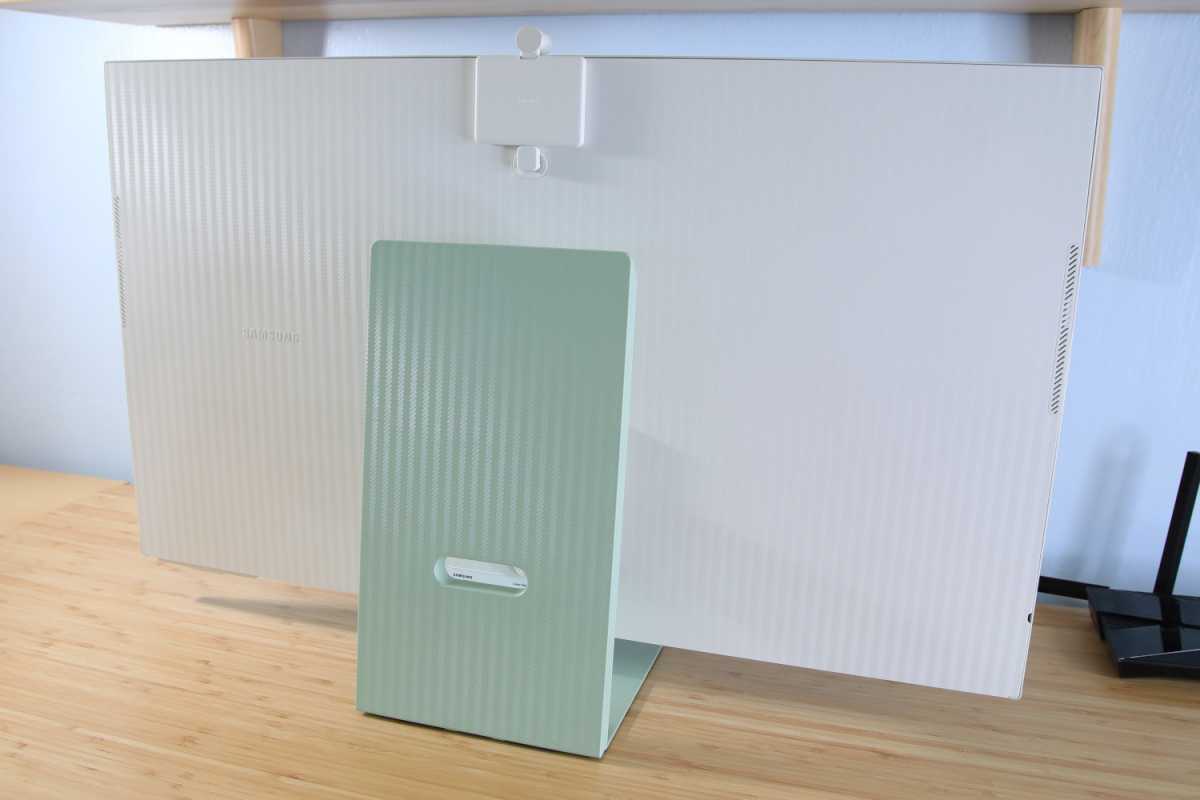
The Samsung Smart Monitor M8 comes in a variety of attractive pastel color options.
Matt Smith
Unlike Apple’s 24-inch iMac, which offers a similar color palette, the M8 Smart Monitor has slim bezels and a small bottom chin. The color applies only to the stand and front chin. This lessens the impact of the color options, but it remains an attractive monitor overall.
Durability is less impressive. The monitor’s plastics allow noticeable flex when handled and panels don’t seem as firmly attached as they could be. This is not a functional issue but a disappointment given the monitor’s premium look and pricing.
There’s issues with the stand, too. It only adjusts for height and tilt. There’s no swivel or pivot option here. A VESA mount is missing, so adding a third-party monitor stand or arm is out of the question.
On the plus side, the stand is compact and narrow for the monitor’s size. This frees up space on your desk and makes the monitor easy to position in small areas.
Samsung M8 Smart Monitor: Features and menu
The “Smart” in Samsung’s M8 Smart Monitor is not just hype. This monitor has Samsung’s Tizen OS, the same one found in its televisions. It only lacks a TV tuner for over-the-air TV or traditional cable service. Tizen supports all the major streaming platforms and Samsung-specific features like DeX and Bixby.
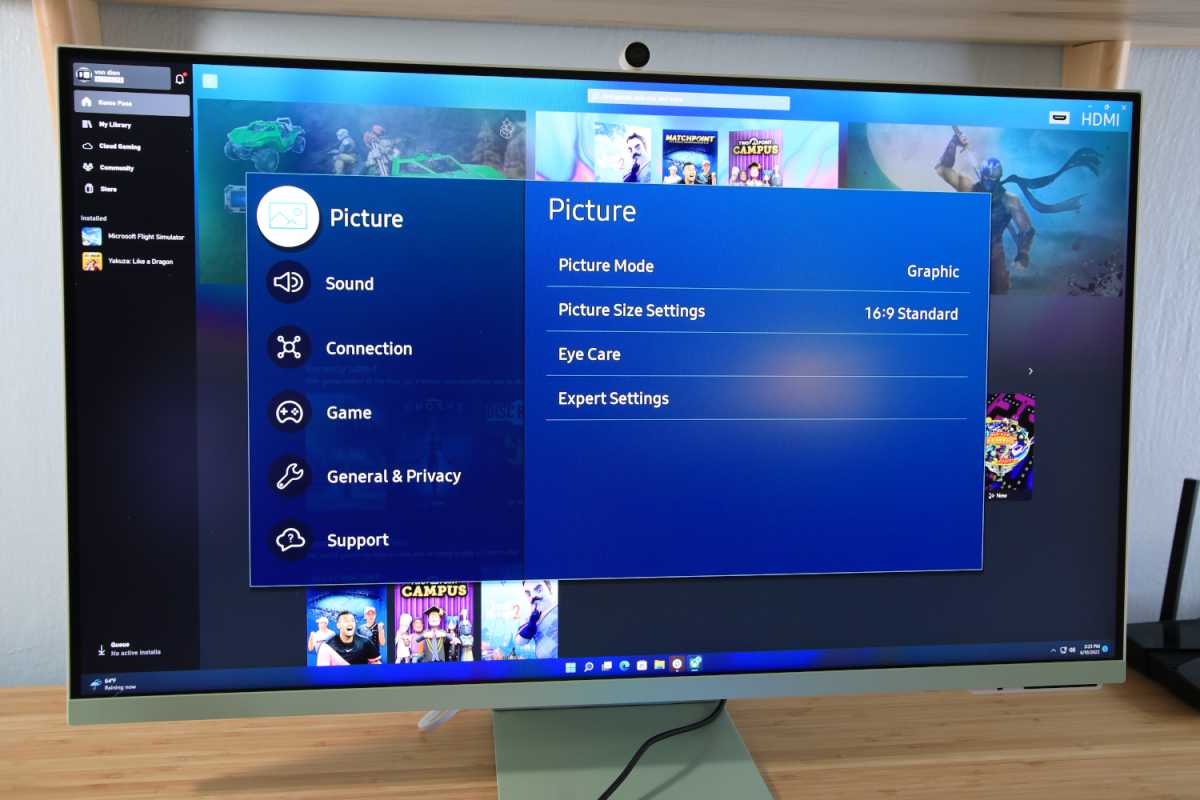
The display comes equipped with Samsung’s Tizen OS for all your streaming needs.
Matt Smith
Why? Some people use a 32-inch display as both a television and a monitor. This is not uncommon in small living spaces and mixed-used areas. The M8 Smart Monitor makes sense in a 400 square-foot apartment, a student’s dorm room, or a mixed-use office and bedroom.
The home screen is controlled with a physical remote included in the package. It’s basic, with just a few buttons, but did the job well enough. Owners can also control the monitor with a phone or tablet using the Samsung SmartThings app. I found this hard to use, however, because the touch controls for selecting items were finicky. There’s also a physical joystick on the rear of the monitor.
These features change the user experience. Most monitors are the very definition of plug and play. The M8 has a setup process, which takes about five minutes and requires both a mobile device and internet connection. And while the M8 of course displays external sources, owners can navigate the home screen and watch streaming services like Netflix without any external device connected.
The M8 Smart Monitor takes a bit longer to turn on and find a signal, and some settings can feel confusing to those used to traditional monitor menus. Switching between sources is more difficult than on a standard monitor. The menus are oversized, which is good for viewing at a distance, but annoying from a desk.
Those who just need a PC monitor will not like these trade-offs. Still, I think Samsung does an admirable job of walking the line between monitor and TV. It delivers the function of both at the cost of a few user-interface quirks.
Samsung M8 Smart Monitor: Connectivity, speakers, and camera
Unfortunately, Samsung stumbles with connectivity. The monitor includes two USB-C inputs. Both have up to 65 watts of Power Delivery but only one supports DisplayPort Alternate Mode. The monitor has HDMI, but uses Micro-HDMI instead of full-sized HDMI (an adapter cable is included). Conventional DisplayPort isn’t available.
This is strange. The M8 is positioned as a mixed-use TV replacement, yet it has just one HDMI port, and it’s not the standard size. Its USB-C connectivity would be suited for a professional workstation monitor, but the monitor’s other features don’t align with this. Adapters will be necessary for many devices.
Speakers are bundled and better suit the M8’s focus on mixed use. They’re loud and provide quality audio at low to medium volume. High volume begins to overwhelm the speakers, leading to a muddy presentation that obscures detail. Still, it’s much better than most monitors and suited to enjoying games or televisions in a small room.
Samsung chalks up yet another miss on connectivity, however, because the monitor lacks a physical audio-out port. Owners can’t easily add a soundbar or speakers to improve audio quality. The monitor does include audio-out over Bluetooth.
The oddities continue with the bundled 1080p webcam. It attaches magnetically to the back of the monitor and provides acceptable image quality. It only works when USB-C is connected, though, as there’s no alternative connection option for devices that lack a USB-C port. The camera does work with apps installed in Tizen OS, making it possible to take a video call on the monitor itself.

Equipped with a handy, if not awkwardly designed camera.
Matt Smith
Samsung M8 Smart Monitor: SDR image quality
The M8’s similarities to a television extend to image quality, providing several advantages over a typical 4K 32-inch monitor.
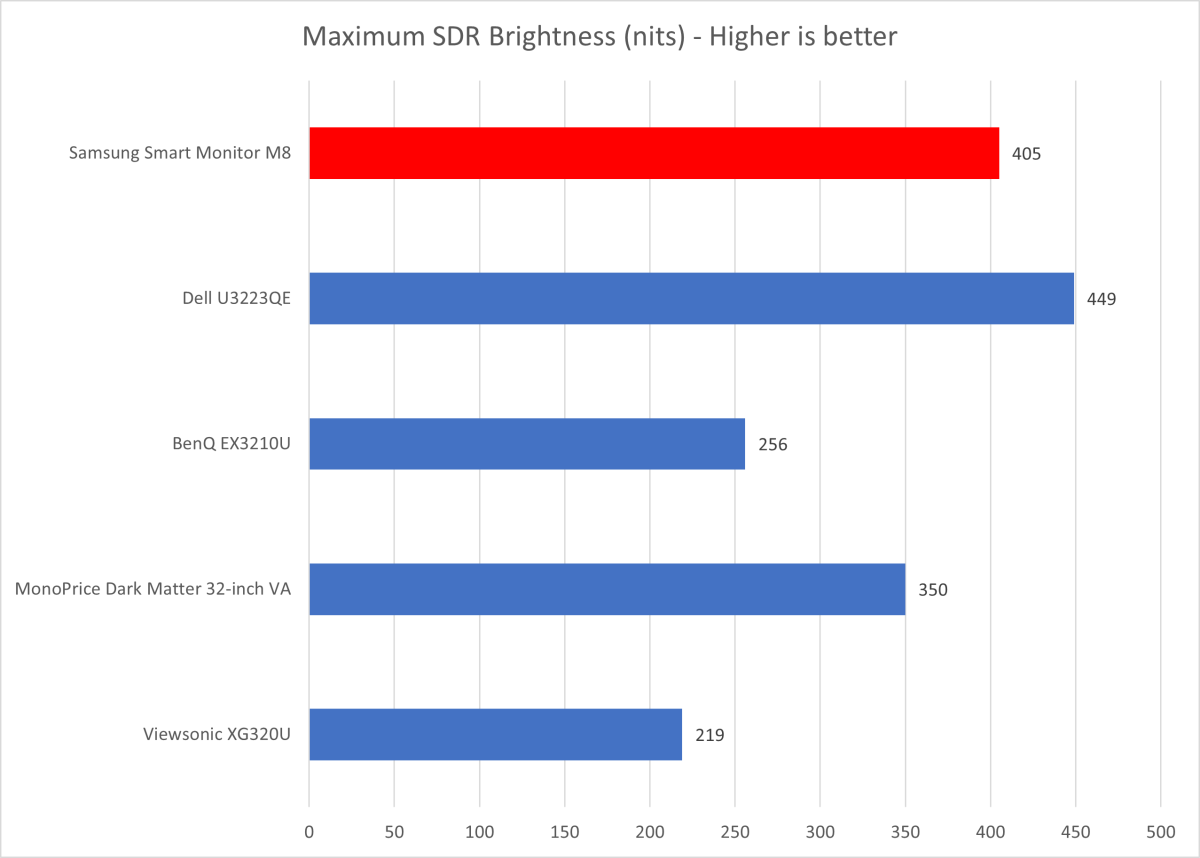
Matt Smith
Brightness is high, if not spectacular, at a maximum of 405 nits. This compares well to most 32-inch monitors, with only a few gaming monitors reaching a higher SDR brightness. It’s easy to view the M8 Smart Monitor in a brightly lit room.

Matt Smith
Contrast ratio is much, much higher than a typical 4K 32-inch monitor thanks to the VA panel, which differs from the IPS panel used in many computer monitors. It can achieve a deeper shade of black without reducing brightness and provides more detail in shadows.
This offers a more realistic image with a good sense of depth and dimensionality. It also helps when watching TV shows or movies, which tend to be darker than a PC desktop or most games. The M8 can bring out details in dark scenes that other monitors will miss.
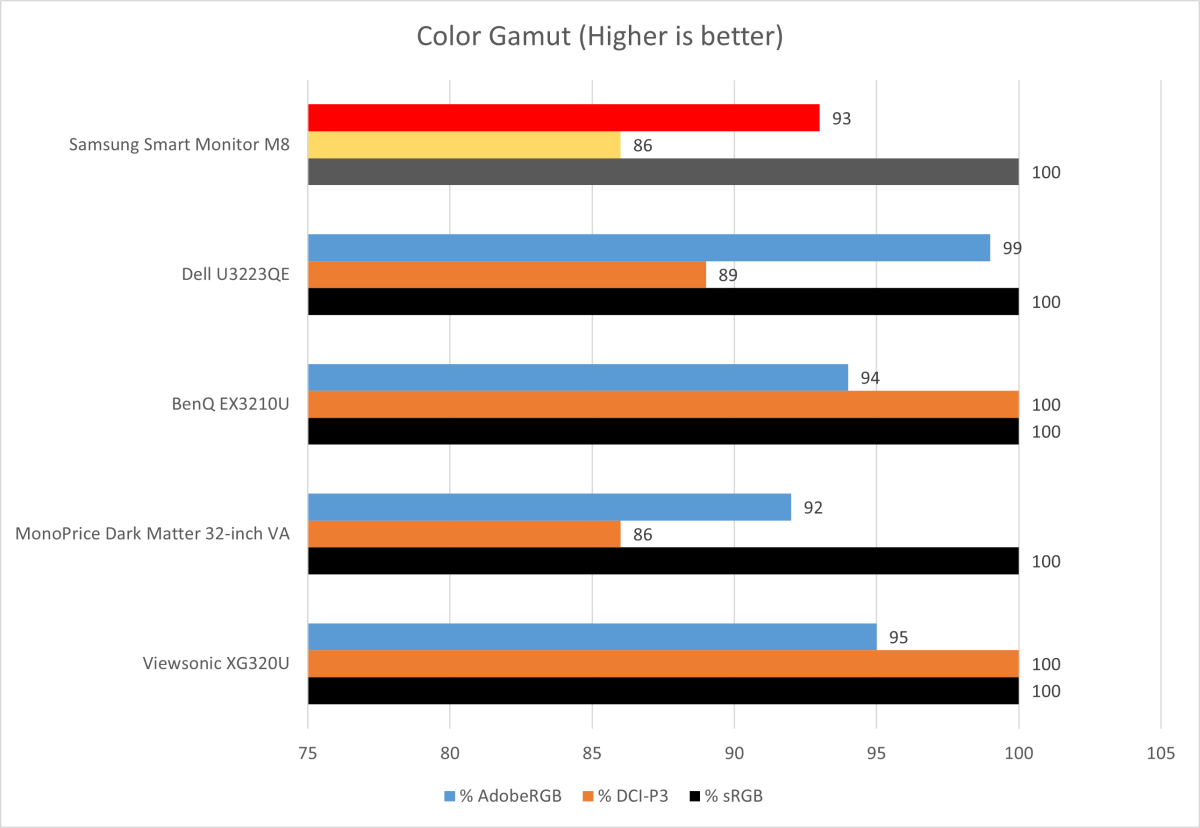
Matt Smith
The M8’s color gamut is a bit narrow for its price, coming in at just 93 percent of the DCI-P3 color gamut. Many 32-inch 4K monitors deliver at least 95 percent of DCI-P3. The M8 can display fewer colors than the competition.
It’s not a problem in most content, but the narrow color gamut will disappoint those looking to use the monitor for professional image or video editing. It also provides a less vivid and saturated experience that may not be to the liking of some owners.
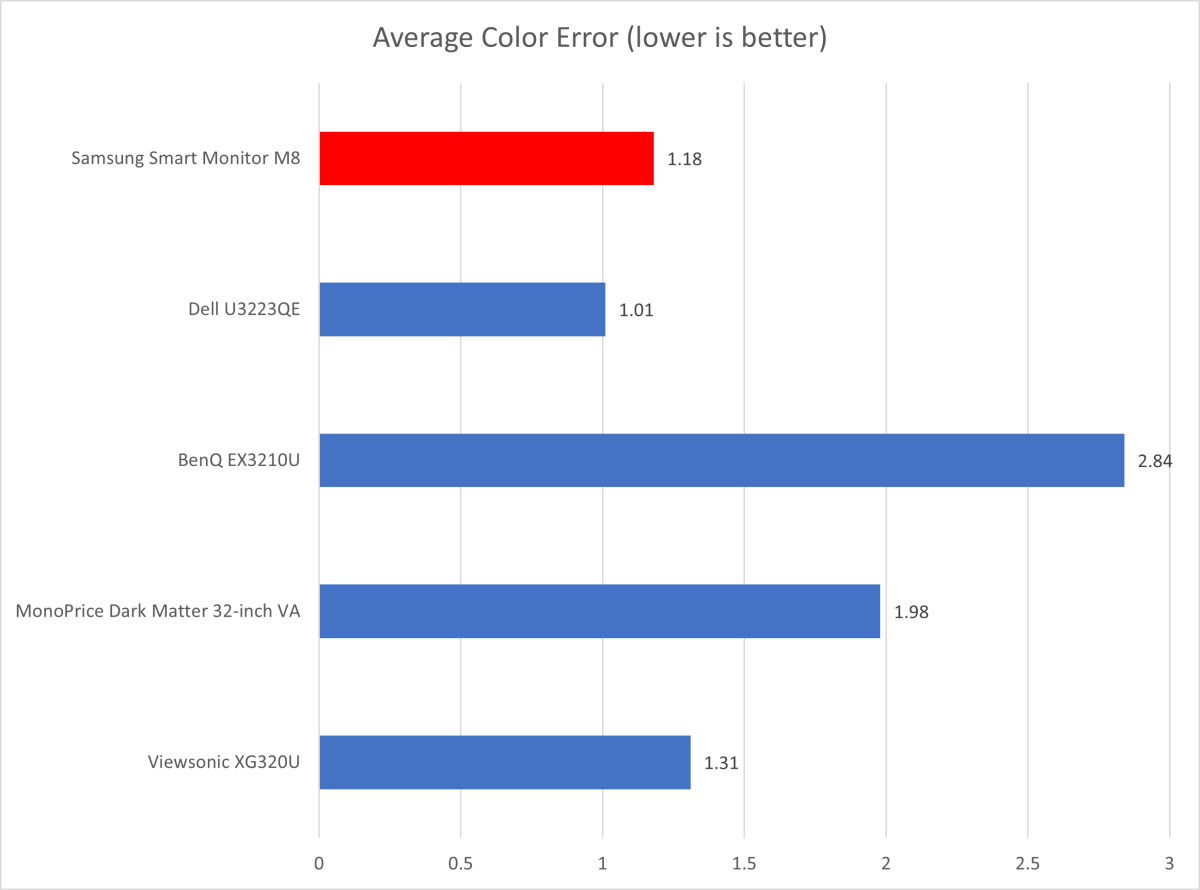
Matt Smith
While the color gamut is just okay, color accuracy is solid. Content looks close to what’s intended. This is most noticeable when viewing “real” content like sports or documentary films. Colors appear believable and lifelike.
My tests showed a default gamma curve of 2.3, a bit off the target of 2.2. This means content is slightly darker than preferred. Color temperature is also a bit off at 7100K, which is cooler and more blue than the target of 6500K. The monitor provides adjustments for both, so you can tune the image to match your preference.
Sharpness is excellent thanks to the monitor’s 4K resolution. Text looks crisp and games look detailed with minimal shimmer and aliasing artifacts. 4K streaming looks outstanding. Perceived sharpness is limited by the quality of a streaming platform’s compression, not the display.
While image quality is great, it’s best when viewed straight-on. The image quickly loses contrast and vibrance when viewed from the side or the top and bottom. It’s critical that owners properly position the monitor in a viewing area.
The M8 Smart Monitor has excellent SDR image quality overall. It suffers setbacks in color gamut and viewing angles but makes up for that with strong contrast and great performance in dark scenes. These traits improve the quality of TV shows and movies compared to many alternative 32-inch 4K monitors. PC games and apps also look attractive.
Samsung M8 Smart Monitor: HDR image quality
The Samsung M8 Smart Monitor supports HDR10+ and automatically detects an HDR signal with the feature on in Windows 11 or a connected game console. The monitor offers both standard and game mode HDR, though I wasn’t able to determine an objective difference between these modes in testing.
Maximum sustained HDR brightness did not appear higher than the SDR mode. That’s a bit disappointing, but puts the M8’s luminance only slightly behind competitive monitors.
The monitor’s superior contrast works to its advantage, providing a wider range of luminance for the monitor to work with. Darker scenes show a better sense of contrast with HDR on. Large bright areas, like a sunset or snowy mountain, look more defined.
These traits put the M8 ahead of most computer monitors that lack Mini-LED or OLED technology, but it has limits. Highlights don’t shine with the brilliance found in truly great HDR monitors like the Asus ROG PG32UQX.
Samsung M8 Smart Monitor: Motion clarity
The Samsung M8 Smart Monitor is a 60Hz display. It also lacks support for adaptive refresh-rate technology, so it can’t sync the refresh rate to the output of a connected PC or game console.
Unsurprisingly, this leads to issues with motion in games. Screen tearing can occur if a game’s frame rate is not well aligned with the monitor’s refresh rate.
Motion clarity is not good. Fast objects look blurry and darker objects show trails behind them. Panning the camera across a scene reduces clarity, making it hard to pick out fine details. The monitor’s Game Mode seems to marginally improve this but still isn’t great.
Games look great, but those who like fast-paced action will find the experience less responsive and may find it hard to pick out details necessary to perform well in competitive titles. The M8 Smart Monitor is a better fit for Microsoft Flight Simulator than Halo Infinite.
A note about image processing
Most monitors display an image with the bare minimum of image processing, but the Samsung M8 Smart Monitor is a bit more involved. It has some de-judder options for improving motion smoothness, for example.
Fortunately, this didn’t harm image quality, and I didn’t notice an increase in input lag compared to a more typical monitor. The de-judder feature caused flickering in some tests with very low frame rates (below 20fps), but this won’t be an issue in normal use, as content with such a frame rate is rare. It’s also possible to turn the feature off.
Final thoughts
Samsung’s M8 Smart Monitor is an alluring option for those who want a display for mixed use in a small space. It’s effectively a television and computer monitor in one package. Image quality is also top-notch.
It’s a sweet deal, but soured by several mistakes. The monitor’s input options are not suited to its intended use. Samsung’s Tizen adds smart TV features but proves confusing to use. There’s no support for adaptive sync or an enhanced refresh rate.
These issues are a barrier but don’t ruin the M8 Smart Monitor. It’s a good choice for those who need the features of a television and PC monitor in one compact display.


